Sunrise Solar Eclipse
June 10, 2021
|
There was an
annular eclipse of the sun on
June 10, 2021, but it was only a partial eclipse
as viewed from the Delaware Valley.
Several WAS members went to
Laurel Run Park in Delran, NJ, to observe the event. This is a
Green Acres site with a former agricultural field overlooking
the Rancocas Creek. We set up just off Creek Rd on the southwest
side of the park, so the distant tree line on the northeast side
along the creek offered a low
horizon to catch the already-eclipsed sun rising at 5:30 am EDT
(maximum eclipse was at 5:32 am). However, clouds along the
horizon obscured the sun until the first cusp of it emerged from
the top of the clouds around 5:44 am, although a brilliant point of light
(presumably the sun) momentarily shone through a fleeting small hole in the
clouds a minute earlier.
All but the final picture were taken with a
Canon EOS
RP mirrorless digital camera and a
Tamron 150 to 600 mm f/5.0 to
6.3 zoom lens on a
Benro TMA38CL Mach 3 carbon fiber tripod with a
Fotopro E-9H gimbal head (here's
the rig in May 2021 aimed at the Lunar X); the
focal length and exposure settings are noted in each caption.
Note on the Time: Because this is an ephemeral
event, I paid extra attention to the picture times. Since the RP
does not have an internal GPS to set the clock and it has a
tendency to run a little fast,
I set it manually on June 9. To calibrate the
time of the eclipse images, I took a picture of the
NIST web clock
when I returned home from Laurel Run and compared
the pictured
time to the time
in the EXIF data. The camera was one (1) second
fast (NIST: 7:28:00 am, RP: 7:28:01 am), so a one-second correction was applied to the times in
these eclipse pictures. Using SkyTools and the picture times, I obtained
the respective solar altitudes (including atmospheric
refraction), which are measured to the center of the sun's
apparent 31.5 arc minute diameter
disc (as opposed to rise time, which is when the refracted upper
limb reaches the horizon). The moon was about 29.6 arc minutes diameter at the time. |
The sun pillar…
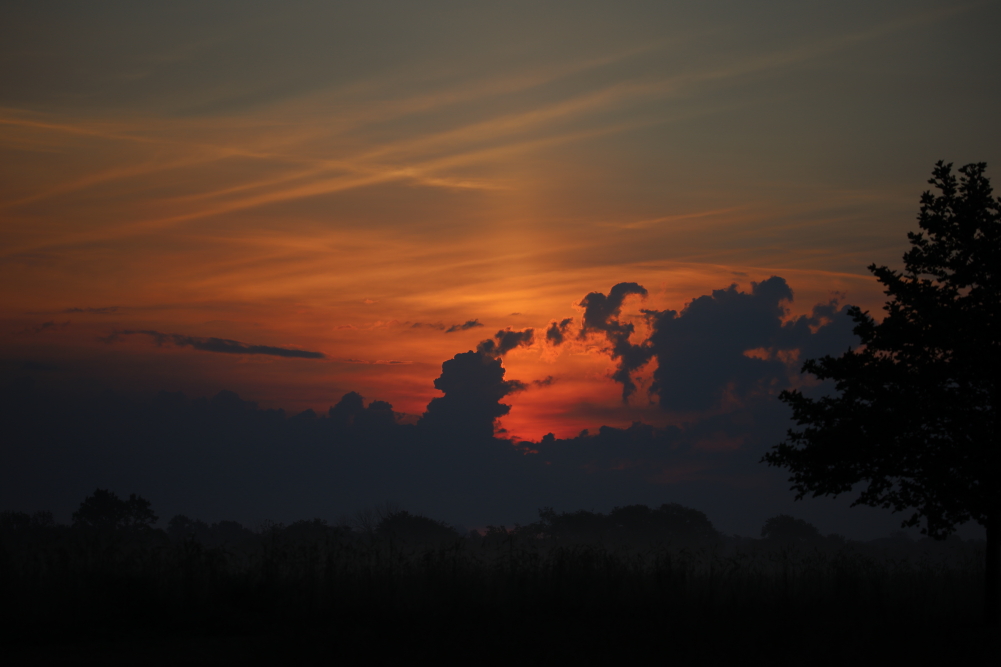
|
While waiting for the eclipsed sun to emerge from the clouds, we
saw a faint sun pillar extending above the obscured sun. Taken at
5:41 am EDT (sun at 1°23′ altitude)
using 150 mm focal length, unfiltered. It was
automatically exposed (minus 1 stop) for 1/160 second
at f/5, ISO 100 and daylight white balance. It's unprocessed and
uncropped for a field 13.6° wide x 9.2° high. |
A cusp of the sun peeks out of the cloud…
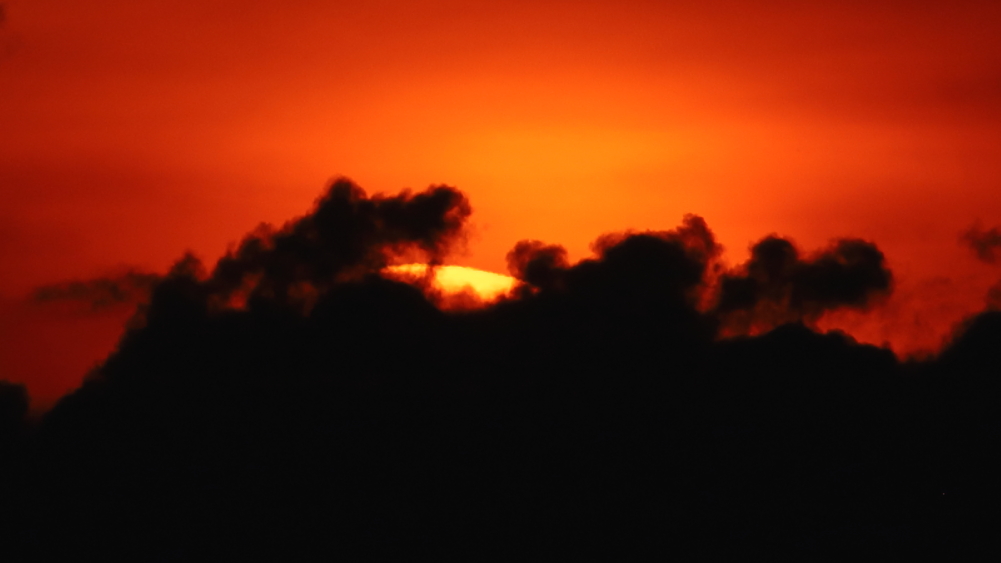
|
The first recognizable bit of the sun to emerge from the clouds.
Taken at 5:44:14 am EDT (sun at
1°53′ altitude) using 600 mm focal length, unfiltered. It was
automatically exposed (minus 2 stops) for 1/640 second
at f/9.0, ISO 200 and daylight white balance. It's unprocessed
but cropped to 26% x 22% of the original linear dimensions (16:9
ratio) for a field 0.88° wide x 0.50° high. |
The partially-eclipsed sun finally appears…
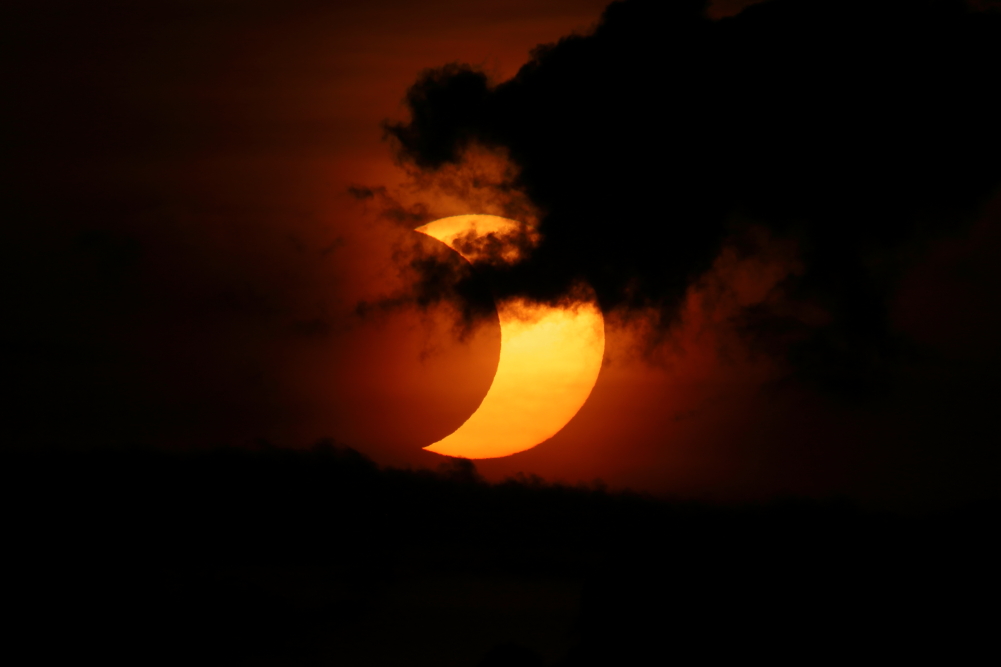
|
The entire extent of the eclipsed sun can now be seen. Taken at
5:51:37 am EDT (sun at 3°02′
altitude) using 600 mm focal length, unfiltered. It
was automatically exposed (minus 3 stops) for 1/4000
second at f/22, ISO 100 and daylight white balance. Cropped to 58% of its original linear dimensions for a field 2.0° wide x
1.3° high, but otherwise unprocessed. |
The foggy field in front of us…
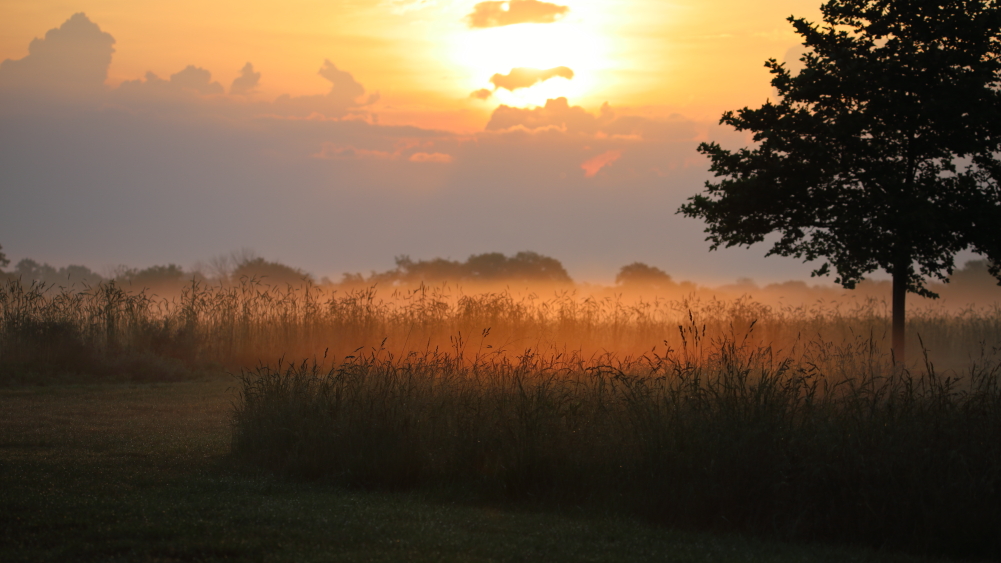
|
Here's the now-weedy, uncultivated field between the observers
and the distant tree line, enshrouded by some ground fog, which
was low enough that it didn't impair our line of sight to the sun. Taken at
5:55:16 am EDT (sun at 3°38′ altitude)
using 150 mm focal length, unfiltered. It
was automatically exposed
for 1/200 second at f/5.6, ISO 100 and daylight white balance. It's
unprocessed, but cropped to 84% of the original height (yielding
a 16:9 ratio) for a field 13.6° wide x 7.7° high.
|
The sun is now higher in a clearing sky, time for a filter…
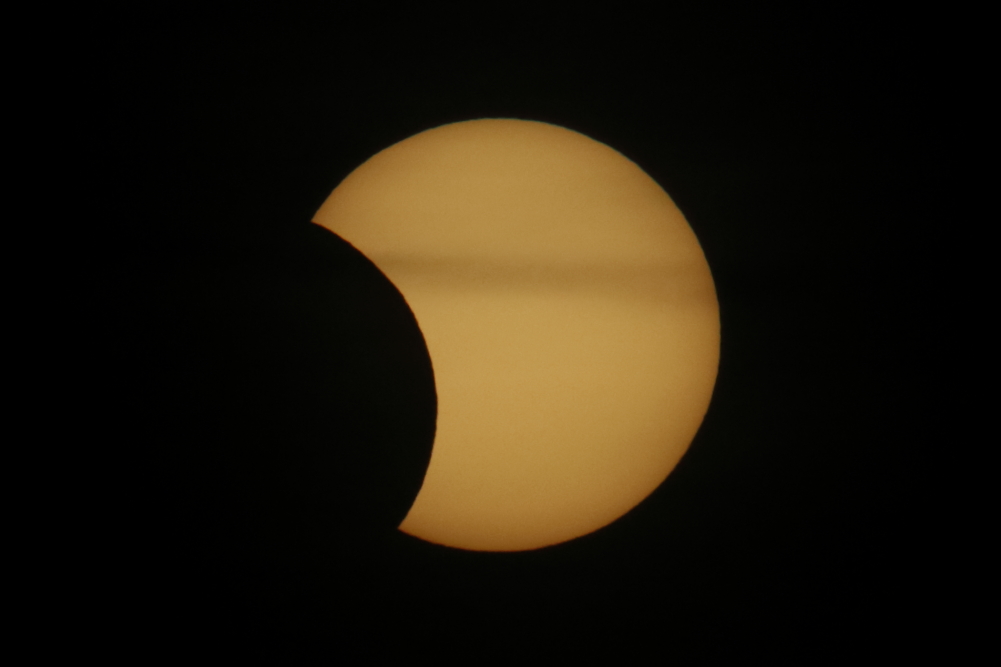
|
After the sun escaped the bulk of the clouds and it was a bit higher in the
sky, the increased brightness required filtration. Taken at
6:08:37 am EDT (sun at 5°51′ altitude)
using 600 mm focal length and an ND-5 filter. It
was manually exposed
for 1/2000 second at f/8.0, ISO 1600 and daylight white balance. It's
unprocessed, but cropped to 34% of the original linear dimensions for a field
1.2° wide x 0.8° high.
The ND-5 neutral density filter, a
Marumi DHG ND-100000, provides 10⁵ (100,000x)
attenuation of the incoming light without altering the color;
the yellowish cast is due to selective absorption by the
sunlight's longer path through the atmosphere at the low
altitude. Note that the next two images were taken with the
exact same equipment and exposure settings, but the sun is
successively slightly brighter in them. That's due mainly to the
sun's increasing altitude and correspondingly reduced
atmospheric absorption, once it emerged from the cloud bank. |
The sky around the sun is now mostly clear…
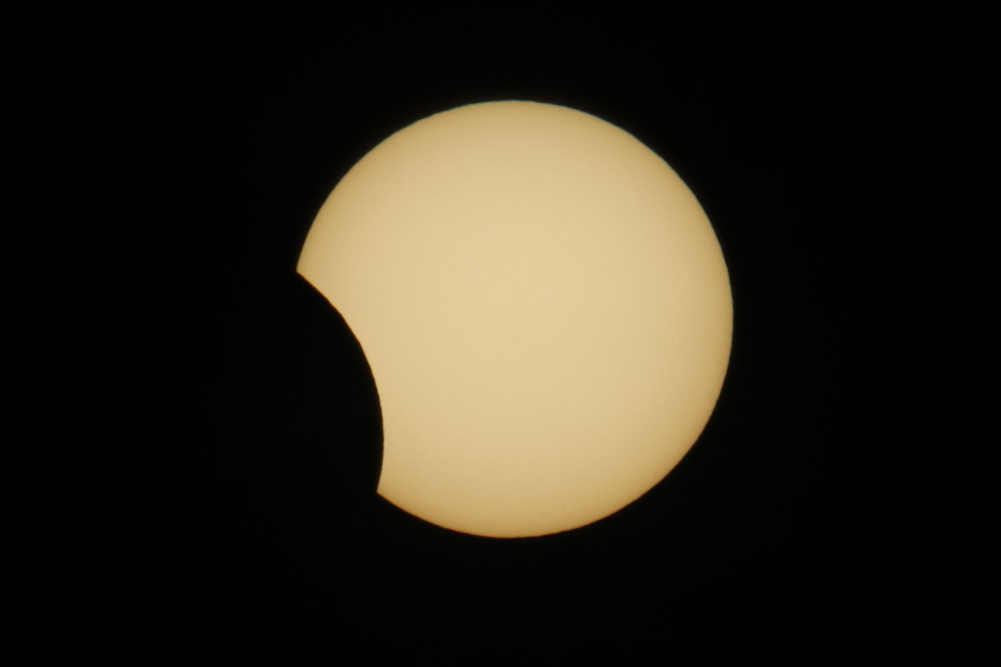
|
The sun continued to move higher in the
sky, a little faster than the moon, so the lunar silhouette
crept further off the northeastern limb of the sun. Taken at
6:19:40 am EDT (sun at 7°44′ altitude)
using 600 mm focal length and an ND 5 filter. It
was manually exposed
for 1/2500 second at f/8.0, ISO 1600 and daylight white balance. It's
unprocessed, but cropped to 34% of the original linear dimensions for a field
1.2° wide x 0.8° high.
|
The eclipse nears the end…
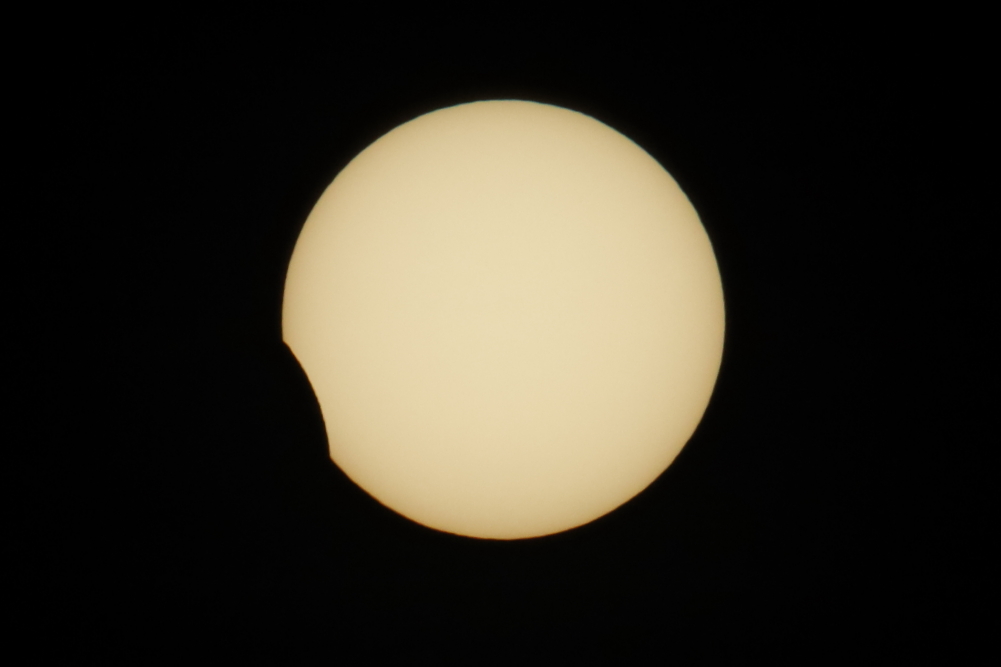
|
This is my final image of the eclipsed sun. Taken
at
6:27:18
am EDT (sun at 9°04′ altitude)
just
before the camera's battery died (I decided to shut down
rather than install a fresh backup battery since the eclipse
would end at 6:30 am). Set to 600 mm focal length with an ND 5
filter. It was manually
exposed for 1/2500 second
at f/8.0, ISO 1600 and daylight white balance. It's unprocessed
but cropped to 34% of the original linear dimensions for a field
1.2° wide x 0.8° high. Because of the still-low
altitude, some atmospheric chromatic aberration (prismatic
dispersion) is
visible as lightly colored edges, bluish at the upper limb,
reddish at the lower limb. |
The observing site…
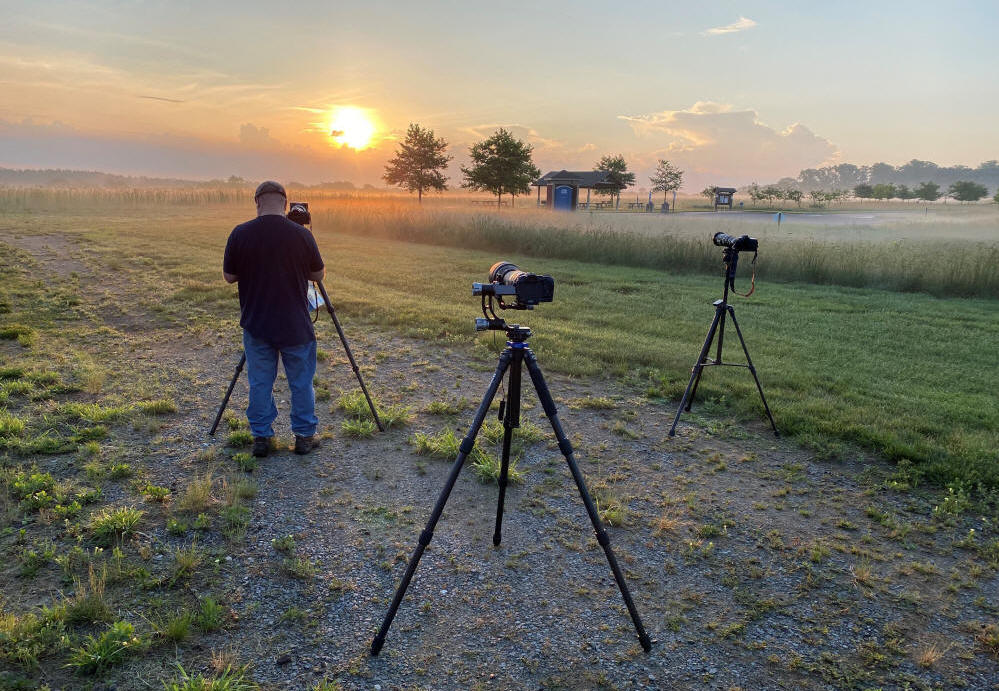
|
Here's an iPhone 11 snapshot at 5:59 am looking
east-northeast towards the sun
emerging from the clouds along the horizon.
Steve M
is on the left, my camera is at the center and
Al M's camera is
on the right. We set up here because the gate to the paved
parking lot at the upper-right corner of the frame
wouldn't be opened by the ranger until after 6 am. Luckily, we weren't
set up on the grass around that parking lot as lawn sprinklers
over there erupted while we were safely observing from this
spot. I didn't even know they had sprinklers! |







